Assignmenthandlers
On this page, you find all documents, package deals, and flashcards offered by seller assignmenthandlers.
- 155
- 0
- 0
Community
- Followers
- Following
155 items
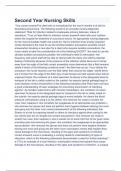
Second Year Nursing Skills
True The client who is immobilized for the next 4 months is at risk for developing pneumonia. The following would be an accurate nursing diagnostic statement: "Risk for Infection related to inadequate primary defenses: stasis of secretions." True or False Risk for infection A client with poor nutrition enters the hospital for treatment of a puncture wound. An appropriate nursing diagnosis for the most immediate health risk would be: risk for infection fever anxiety impaired s...
- Exam (elaborations)
- • 6 pages •
True The client who is immobilized for the next 4 months is at risk for developing pneumonia. The following would be an accurate nursing diagnostic statement: "Risk for Infection related to inadequate primary defenses: stasis of secretions." True or False Risk for infection A client with poor nutrition enters the hospital for treatment of a puncture wound. An appropriate nursing diagnosis for the most immediate health risk would be: risk for infection fever anxiety impaired s...
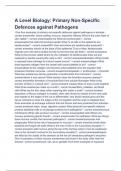
A Level Biology: Primary Non-Specific Defences against Pathogens
Give four examples of primary non-specific defences against pathogens in animals skin, blood clotting, mucous, expulsive reflexes What is the outer layer of skin called? epidermis What are kertinocytes? epidermal cells that produce karatin What % of cells in the epidermis are keratinocytes? 90% How and where are keratinocytes produced? by mitosis at the base of the epidermis True or false: keratinocytes migrate out to the skins surface but die by the time ...
- Exam (elaborations)
- • 2 pages •
Give four examples of primary non-specific defences against pathogens in animals skin, blood clotting, mucous, expulsive reflexes What is the outer layer of skin called? epidermis What are kertinocytes? epidermal cells that produce karatin What % of cells in the epidermis are keratinocytes? 90% How and where are keratinocytes produced? by mitosis at the base of the epidermis True or false: keratinocytes migrate out to the skins surface but die by the time ...
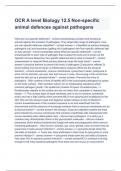
OCR A level Biology 12.5 Non-specific animal defences against pathogens
What are non-specific defences? always present and working to prevent against the invasion of pathogens. They target all/a range of pathogens. How are non-specific defences classified? --> Classified as primary (keeping pathogens out) and secondary (getting rid of pathogens) Are Non-specific defences fast or slow acting? fast acting What are specific defences? specific to each type of pathogen that invades the body and is known as the 'Specific Immune Response' ...
- Exam (elaborations)
- • 5 pages •
What are non-specific defences? always present and working to prevent against the invasion of pathogens. They target all/a range of pathogens. How are non-specific defences classified? --> Classified as primary (keeping pathogens out) and secondary (getting rid of pathogens) Are Non-specific defences fast or slow acting? fast acting What are specific defences? specific to each type of pathogen that invades the body and is known as the 'Specific Immune Response' ...
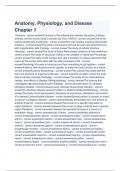
Anatomy, Physiology, and Disease Chapter 1
Anatomy The study of the internal and external structures of plants, animals, and the human body Leonardo da Vinci (1400's) One of the earliest anatomists Anatomists One who studies anatomy Microscopic anatomy The study of structures that can be seen and examined only with magnification aids Cytology The study of cellular structure Histology The study of tissue Macroscopic anatomy (Gross anatomy) The study of structures visible to the unaided or ...
- Exam (elaborations)
- • 2 pages •
Anatomy The study of the internal and external structures of plants, animals, and the human body Leonardo da Vinci (1400's) One of the earliest anatomists Anatomists One who studies anatomy Microscopic anatomy The study of structures that can be seen and examined only with magnification aids Cytology The study of cellular structure Histology The study of tissue Macroscopic anatomy (Gross anatomy) The study of structures visible to the unaided or ...
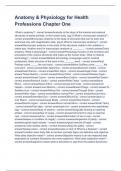
Anatomy & Physiology for Health Professions Chapter One
What is anatomy? Anatomy is the study of the internal and external structures of plants,animals, or the human body. (pg.2) What is microscopic anatomy? Microscopic anatomy is the study of structures that can be seen and examined only with magnification aids. (pg.2) What is macroscopic anatomy? Macroscopic anatomy is the study of the structures visible to the unaided or naked eye. Another word for macroscopic anatomy is ________. Gross anatomy. What is physiology? ...
- Exam (elaborations)
- • 2 pages •
What is anatomy? Anatomy is the study of the internal and external structures of plants,animals, or the human body. (pg.2) What is microscopic anatomy? Microscopic anatomy is the study of structures that can be seen and examined only with magnification aids. (pg.2) What is macroscopic anatomy? Macroscopic anatomy is the study of the structures visible to the unaided or naked eye. Another word for macroscopic anatomy is ________. Gross anatomy. What is physiology? ...
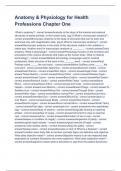
Anatomy & Physiology for Health Professions Chapter One
What is anatomy? Anatomy is the study of the internal and external structures of plants,animals, or the human body. (pg.2) What is microscopic anatomy? Microscopic anatomy is the study of structures that can be seen and examined only with magnification aids. (pg.2) What is macroscopic anatomy? Macroscopic anatomy is the study of the structures visible to the unaided or naked eye. Another word for macroscopic anatomy is ________. Gross anatomy. What is physiology? ...
- Exam (elaborations)
- • 2 pages •
What is anatomy? Anatomy is the study of the internal and external structures of plants,animals, or the human body. (pg.2) What is microscopic anatomy? Microscopic anatomy is the study of structures that can be seen and examined only with magnification aids. (pg.2) What is macroscopic anatomy? Macroscopic anatomy is the study of the structures visible to the unaided or naked eye. Another word for macroscopic anatomy is ________. Gross anatomy. What is physiology? ...
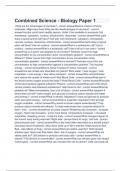
Combined Science - Biology Paper 1
What are the advantages of vaccines? Reduce chance of future outbreaks. Might save lives What are the disadvantages of vaccines? Vaccine could harm healthy person. Unfair if not available to everyone Cell membrane, cytoplasm, nucleus, mitochondria, ribosomes What parts does a typical animal cell have? Cell wall, cell membrane, cytoplasm, chloroplasts, vacuole, nucleus, ribosomes, mitochondria What parts does a typical plant cell have? Has no nucleus What is a pro...
- Exam (elaborations)
- • 5 pages •
What are the advantages of vaccines? Reduce chance of future outbreaks. Might save lives What are the disadvantages of vaccines? Vaccine could harm healthy person. Unfair if not available to everyone Cell membrane, cytoplasm, nucleus, mitochondria, ribosomes What parts does a typical animal cell have? Cell wall, cell membrane, cytoplasm, chloroplasts, vacuole, nucleus, ribosomes, mitochondria What parts does a typical plant cell have? Has no nucleus What is a pro...

Anatomy and Physiology In Health and Disease
Antibiotic a substance that acts against bacteria; it inhibits bacterial growth Bacteria a single-celled microscopic organism that does not contain a nucleus Body Cavity a region or space containing organs in a multicellular organism Cells basic unit of structure for all living things Diaphragm a large muscle that aids in breathing Mediastinum the middle section of the chest activity Meninges membranes that cover the rain and spinal cord Mu...
- Exam (elaborations)
- • 2 pages •
Antibiotic a substance that acts against bacteria; it inhibits bacterial growth Bacteria a single-celled microscopic organism that does not contain a nucleus Body Cavity a region or space containing organs in a multicellular organism Cells basic unit of structure for all living things Diaphragm a large muscle that aids in breathing Mediastinum the middle section of the chest activity Meninges membranes that cover the rain and spinal cord Mu...
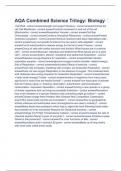
AQA Combined Science Trilogy: Biology
Cell Wall strength and support Nucleus Controls the cell Cell Membrane Controls movement in and out of the cell Mitochondria Respiration Vacuole Cell Sap Chloroplasts Contains chlorophyll Ribosomes Protein synthesis Cytoplasm Chemical reactions take place Specialised cells Carry out specific functions How are sperm cells adapted? Full of mitochondria to release energy for the tail to swim Tissues Group of cells with...
- Exam (elaborations)
- • 1 pages •
Cell Wall strength and support Nucleus Controls the cell Cell Membrane Controls movement in and out of the cell Mitochondria Respiration Vacuole Cell Sap Chloroplasts Contains chlorophyll Ribosomes Protein synthesis Cytoplasm Chemical reactions take place Specialised cells Carry out specific functions How are sperm cells adapted? Full of mitochondria to release energy for the tail to swim Tissues Group of cells with...
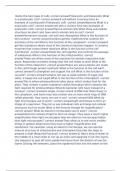
AQA GCSE Combined Science Trilogy : Biology Paper 1
AQA GCSE Combined Science Trilogy : Biology Paper 1 Share Flashcards
- Exam (elaborations)
- • 20 pages •
AQA GCSE Combined Science Trilogy : Biology Paper 1 Share Flashcards
